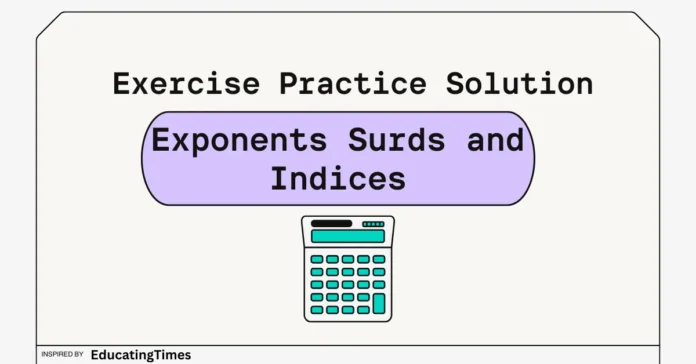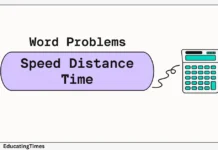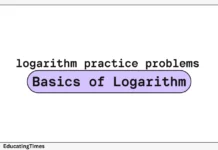Exponents, Surds, and Indices
Exponents, also known as powers or indices, are a way of representing repeated multiplication of a number by itself. An exponent is usually written as a small superscript number to the right of the base number. For example, 3 raised to the power of 2 is written as 3², which means 3 multiplied by itself twice, or 3 x 3 = 9.
Exponents Rules
Product Rule: When multiplying powers with the same base, keep the base and add the exponents.
For example, a^m x a^n = a^(m+n).
Quotient Rule: When dividing powers with the same base, keep the base and subtract the exponents.
For example, a^m ÷ a^n = a^(m-n).
Power Rule: When raising a power to another power, keep the base and multiply the exponents.
For example, (a^m)^n = a^(m*n).
Zero Rule: Any non-zero number raised to the power of 0 is equal to 1.
For example, a^0 = 1.
Negative Rule: Any non-zero number raised to a negative power is equal to 1 divided by the number raised to the positive power.
For example, a^(-n) = 1/a^n.
Example 1: Evaluate 5³
Solution:
5³ means 5 raised to the power of 3, or 5 multiplied by itself three times: 5 x 5 x 5 = 125. Therefore, 5³ = 125.
Example 2: Simplify (2²)³
Solution:
First, we need to evaluate the expression inside the brackets: 2² = 2 x 2 = 4. Now we can substitute this value into the original expression: (2²)³ = 4³ = 4 x 4 x 4 = 64.
Also Practice – A Guide to Averages: Understanding and Calculating the Mean
Surds Rules
Simplification Rule: A surd can be simplified if it has a square factor in the radicand.
For example, √50 can be simplified as √(25 x 2) = 5√2.
Addition and Subtraction Rule: Surds can only be added or subtracted if they have the same radicand.
For example, √2 + √2 = 2√2.
Surds are irrational numbers that cannot be expressed exactly as a finite decimal or a fraction. They are often represented by the symbol √, which is called the radical symbol. The number under the radical symbol is called the radicand. For example, √2 is a surd because it is an irrational number.
Example 1: Simplify √18
Solution:
We can simplify √18 by breaking it down into its prime factors: 18 = 2 x 3 x 3. Then, we can rewrite √18 as √(2 x 3 x 3). Using the product rule of surds, we can separate the radical into two parts: √(2 x 3) x √3. Simplifying the first part gives us √6. Therefore, √18 = √6 x √3.
Example 2: Simplify 5√27
Solution:
First, we need to simplify the radical. We can break down 27 into its prime factors: 27 = 3 x 3 x 3. Then, we can rewrite 5√27 as 5 x √(3 x 3 x 3). Using the product rule of surds, we can separate the radical into three parts: √3 x √3 x √3. Simplifying each part gives us 3√3. Therefore, 5√27 = 5 x 3√3 = 15√3.
Also Practice – How to Calculate Total Values Using Averages in Mathematics
Indices Rules
Product Rule: When multiplying bases with the same index, keep the index and add the exponents.
For example, a^m x b^m = (ab)^m.
Quotient Rule: When dividing bases with the same index, keep the index and subtract the exponents.
For example, a^m ÷ b^m = (a/b)^m.
Power Rule: When raising a base to another power, keep the base and multiply the index.
For example, (ab)^m = a^m x b^m.
Negative Rule: Any non-zero base raised to a negative index is equal to 1 divided by the base raised to the positive index.
For example, a^(-m) = 1/a^m.
Indices, also known as powers or exponents, are a way of representing repeated multiplication of a number by itself. They are similar to exponents, but instead of using superscript numbers, they use subscript numbers. For example, 2 to the power of 3 is written as 2³, while 2 raised to the index of 3 is written as 2₃.
Example 1: Evaluate 4₃ x 2₄
Solution:
4₃ means 4 raised to the index of 3, or 4 multiplied by itself three times: 4 x 4 x 4 = 64. Similarly, 2₄ means 2 raised to the index of 4, or 2 multiplied by itself four times: 2 x 2 x 2 x 2 = 16. Therefore, 4₃ x 2₄ = 64 x 16 = 1024.
Example 2: Simplify (5x)² ÷ (25x²)
Solution:
First, we need to evaluate the expression inside the brackets: (5x)² = 5x x 5x = 25x². Now we can substitute this value into the original expression: (5x)² ÷ (25x²) = 25x² ÷ (25x²). Using the quotient rule of indices, we can subtract the exponents: 25x² ÷ (25x²) = 1. Therefore, (5x)² ÷ (25x²) simplifies to 1.
Also Practice – Understanding Median and Mode
Practice Questions on Exponents, Surds, and Indices
Evaluate 2³ x 5².
Solution:
2³ x 5² = 2 x 2 x 2 x 5 x 5 = 8 x 25 = 200.
Simplify √(3² x 2⁴).
Solution:
√(3² x 2⁴) = √(9 x 16) = √144 = 12.
Evaluate 4³ x 2⁶.
Solution:
4³ x 2⁶ = 4 x 4 x 4 x 2 x 2 x 2 x 2 x 2 x 2 = 64 x 64 = 4096.
Simplify √(8x² y³).
Solution:
√(8x² y³) = √(2² x 2 x x² x y³) = 2xy√2y.
Evaluate 3² + 4².
Solution:
3² + 4² = 9 + 16 = 25.
Simplify √(10² + 24²).
Solution:
√(10² + 24²) = √(100 + 576) = √676 = 26.
Evaluate 2⁴ ÷ 2².
Solution:
2⁴ ÷ 2² = 16 ÷ 4 = 4.
Simplify √(3⁴ x 5³).
Solution:
√(3⁴ x 5³) = √(81 x 125) = √10125 = 45.
Evaluate 5⁴.
Solution:
5⁴ = 5 x 5 x 5 x 5 = 625.
Simplify √(16x⁶).
Solution:
√(16x⁶) = √(4² x x⁶) = 4x³.
Evaluate 6² – 3².
Solution:
6² – 3² = 36 – 9 = 27.
Simplify (4² – 3²) ÷ (4 + 3).
Solution:
(4² – 3²) ÷ (4 + 3) = (16 – 9) ÷ 7 = 1
Evaluate (5³)².
Solution:
(5³)² = 5⁶ = 15625
Simplify √(2⁴ x 3²) ÷ √(2² x 9).
Solution:
√(2⁴ x 3²) ÷ √(2² x 9) = 2√3
Evaluate 2⁵ x 3² x 5 ÷ 3³.
Solution:
2⁵ x 3² x 5 ÷ 3³ = 32 x 9 x 5 ÷ 27 = 160 ÷ 27
Simplify 4³ x 5² ÷ 10.
Solution:
4³ x 5² ÷ 10 = 64 x 25 ÷ 10 = 160
Evaluate √(7⁴) ÷ 7².
Solution:
√(7⁴) ÷ 7² = 49 ÷ 49 = 1
Simplify √(27x² y³).
Solution:
√(27x² y³) = √(3³ x x² x y³) = 3xy√3y.
Evaluate 10³ x 2⁴.
Solution:
10³ x 2⁴ = 1000 x 16 = 16000.
Simplify √(5² + 12²).
Solution:
√(5² + 12²) = √(25 + 144) = √169 = 13.
Evaluate 3³ x 2².
Solution:
3³ x 2² = 3 x 3 x 3 x 2 x 2 = 27 x 4 = 108.
Simplify √(3⁶ ÷ 3²).
Solution:
√(3⁶ ÷ 3²) = √(3⁴) = 3² = 9
Evaluate 5⁵ ÷ 5³.
Solution:
5⁵ ÷ 5³ = 5² = 25
Simplify √(5x)² + √(5x)².
Solution:
√(5x)² + √(5x)² = (5x) + (5x) = 10x
Evaluate 2⁴ x 3³ ÷ 6².
Solution:
2⁴ x 3³ ÷ 6² = 16 x 27 ÷ 36 = 12
Simplify √(3x²y⁴) ÷ √(xy²).
Solution:
√(3x²y⁴) ÷ √(xy²) = y√(3y²) ÷ √(x) = y√(3y² ÷ x)
Evaluate (7² + 8²) x 2³.
Solution:
(7² + 8²) x 2³ = (49 + 64) x 8 = 936
Simplify 3⁵ ÷ 3² + 3³.
Solution:
3⁵ ÷ 3² + 3³ = 81 + 27 = 108
Evaluate √(2² + 3²) x 5³.
Solution:
√(2² + 3²) x 5³ = √13 x 125 = 1625√13
Simplify 2⁶ x 5² ÷ 10⁴.
Solution:
2⁶ x 5² ÷ 10⁴ = 64 x 25 ÷ 10000 = 0.16
Evaluate √(2³ x 3²) ÷ √(2² x 3³).
Solution:
√(2³ x 3²) ÷ √(2² x 3³) = 3√2 ÷ 2√3
Simplify √(10⁸) ÷ 10².
Solution:
√(10⁸) ÷ 10² = 10⁴ ÷ 10² = 100
Simplify (a³b²c)² ÷ (abc³)³.
Solution:
(a³b²c)² ÷ (abc³)³ = a⁶b⁴c² ÷ a³b³c⁹ = a³b⁴ ÷ c⁷
Evaluate 5⁴ – 4⁴.
Solution:
5⁴ – 4⁴ = (5² + 4²) (5² – 4²) = 41 x 9 = 369
Simplify 2√(2) x √(8).
Solution:
2√(2) x √(8) = 2√(16) = 8
Evaluate (6⁵ x 9²) ÷ (2⁷ x 3³).
Solution:
(6⁵ x 9²) ÷ (2⁷ x 3³) = (2³ x 3²) x 6² ÷ (2⁷ x 3³) = 27 ÷ 8
Simplify (a² – b²) ÷ (a – b).
Solution:
(a² – b²) ÷ (a – b) = (a + b)(a – b) ÷ (a – b) = a + b
Evaluate (2³ + 3³) ÷ (2² – 2 x 3 + 3²).
Solution:
(2³ + 3³) ÷ (2² – 2 x 3 + 3²) = 35 ÷ 1 = 35
Simplify 3⁵ x 9⁴ ÷ 27².
Solution:
3⁵ x 9⁴ ÷ 27² = 3⁵ x (3²)⁴ ÷ (3²)⁴ = 3⁵
Evaluate √(20² – 16²).
Solution:
√(20² – 16²) = √(336) = 4√21
Simplify 5² x 7⁴ ÷ 35.
Solution:
5² x 7⁴ ÷ 35 = 5² x 7³ = 1225
Simplify √(2 + √3) x √(2 – √3).
Solution:
√(2 + √3) x √(2 – √3) = √(4 – 3) = 1
Evaluate 8² + 6³ ÷ 3².
Solution:
8² + 6³ ÷ 3² = 64 + 72 = 136
Simplify √(25 + 10√6) – √(25 – 10√6).
Solution:
√(25 + 10√6) – √(25 – 10√6) = √[(5 + √6)²] – √[(5 – √6)²] = 5 + √6 – (5 – √6) = 2√6
Evaluate 3⁴ x 7³ ÷ 21².
Solution:
3⁴ x 7³ ÷ 21² = 3⁴ x (7 ÷ 21)² = 3⁴ ÷ 3² = 3² = 9
Simplify (a – b)(a² + ab + b²).
Solution:
(a – b)(a² + ab + b²) = a³ – b³
Evaluate 2³ x (2² + 2 + 1) – 3⁴.
Solution:
2³ x (2² + 2 + 1) – 3⁴ = 8 x 7 – 81 = 7
Simplify (5 + 2√2)².
Solution:
(5 + 2√2)² = 25 + 20√2 + 8 = 33 + 20√2
Evaluate 7³ – 3⁵ + 2⁸ ÷ 2².
Solution:
7³ – 3⁵ + 2⁸ ÷ 2² = 343 – 243 + 64 = 164
Simplify (a⁴ – b⁴) ÷ (a² – b²).
Solution:
(a⁴ – b⁴) ÷ (a² – b²) = (a² + b²)(a² – b²) ÷ (a² – b²) = a² + b²
Evaluate 6³ x 7² ÷ 42.
Solution:
6³ x 7² ÷ 42 = 6³ x (7 ÷ 6)² ÷ 6 = 49











